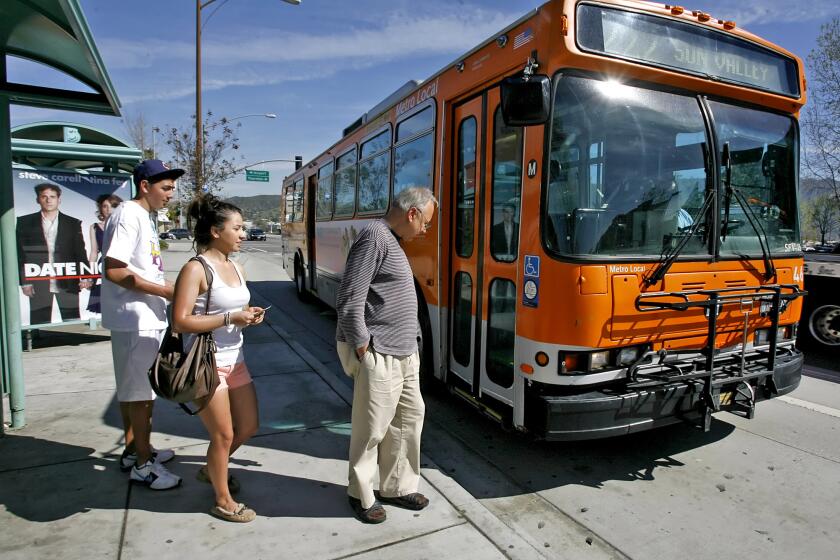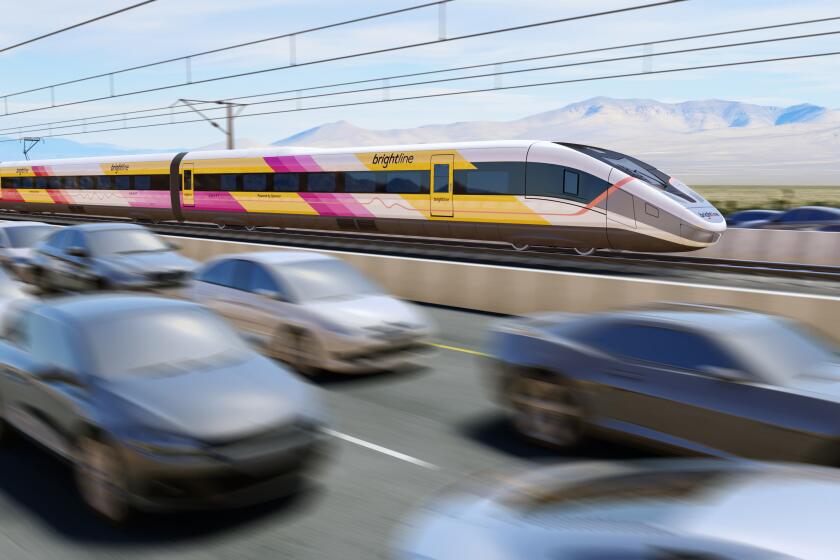Jan. 11 Start Planned for Red Line Subway : Transit: Officials say problems with the trains’ supplemental brakes have been solved. But a decision on which police agency will patrol the system has not yet been made.
County transit officials said Thursday that they are working toward opening the Metro Red Line subway Jan. 11 after expressing confidence that they have sorted out problems with the train system’s supplemental brakes.
Announcement of the tentative start date, which is two months ahead of schedule, leaves only one major issue to be resolved--which police agency will patrol the subway.
Although the Los Angeles County Transportation Commission will not take up the potentially messy issue until next month, the Los Angeles Police Department and Southern California Rapid Transit District Transit Police Department already are competing for the job.
The Los Angeles City Council is scheduled to formally approve the LAPD plan to bid for the contract today. The council’s Public Safety Committee on Monday recommended approval of the LAPD’s bid, citing the benefits of coordinating security above ground and below.
Opening day for the subway had been held up by a nagging problem with the subway cars. They would not slow by coasting on their electric motors--a process that also generates electricity and improves the trains’ efficiency. The short-circuiting problem eventually was traced to two flaws, faulty diodes and inadequate weatherstripping; both are being repaired.
Neither the LAPD nor RTD would be specific about what they plan to propose for the 4.4-mile first segment of the subway, but sources in the county’s transit agencies estimated that the task would require as many as 30 to 35 officers.
Based on the cost of security on the Metro Blue Line, a force that size could cost between $3.9 million and $4.6 million a year.
That figure would represent about one-third of the amount the RTD budgets for security on all its 2,100 buses, and it is likely to heat up the debate over whether inner-city bus riders receive second-class service while millions are lavished on the region’s new train lines.
The RTD has estimated that $1.25 is spent on security for each Blue Line train rider, but only about 3 cents is spent on security for each bus passenger.
In the past, the LACTC has said train security is vital to winning public acceptance of the rail system. Without making that system as attractive as possible, they contended, the congestion-fighting and smog-cutting benefits from the region’s multibillion-dollar investment in trolley lines and subways may be diminished.
At the same time, Neil Peterson, executive director of the commission, said that improving bus security will be his “highest priority in the next three to four months,” and he has formed a task force to find some ways to cut down on bus crime.
“Nobody in the country has a good way to do that (fight crime on buses),” he said. “Now that we’ve done it on trains, we are committed to try to do the same on buses. But there is a real issue of how to do it.”
He said the task force is scheduled to report back to him in 90 days.
Regardless of equity, the process of selecting a police force for the Red Line may open old wounds in the RTD transit force’s rank and file. Twice the members of the RTD board of directors decided to use transit police to patrol the Blue Line and twice the commission board forced them to recant in favor of Los Angeles County sheriff’s deputies.
LACTC officials said the deputies were more experienced and professional, and thus worth the additional cost. That premium was estimated to be as high as $3 million a year.
Security on the Blue Line accounts for nearly a third of its total operating costs. In comparison, security on New York City buses and subways is estimated to account for 8% of that system’s operating costs.
The twin rejections, both made in public amid considerable rancor, badly hurt morale among the 198-member transit police force, union leaders said.
Several of the county’s top transit officials, speaking on the condition of anonymity, said they believed the LACTC has designed the Red Line to accommodate the LAPD--for example, by revamping the emergency communications system at a cost of $2 million to be compatible with the city force’s radio system.
This, they said, indicates a preference--if not a prejudice--for the LAPD.
Peterson flatly denied any predisposition to either police agency.
“There can’t be a deal struck,” he said. “It takes the approval of the city for the LAPD to bid for the job, and it takes the approval of the (LACTC) board to select a bidder. Neither event has happened yet.”
RTD Police Chief Sharon Papa also downplayed the significance of the communications system. She said the LAPD inevitably would be called on for help with any major incident, and once the LAPD officers are underground, they would need a reliable and compatible radio system.
Selection of the LAPD to patrol the Red Line could have dividends for the city, however, by providing new money--transit funds--to expand the depleted LAPD.
More to Read
Start your day right
Sign up for Essential California for news, features and recommendations from the L.A. Times and beyond in your inbox six days a week.
You may occasionally receive promotional content from the Los Angeles Times.






